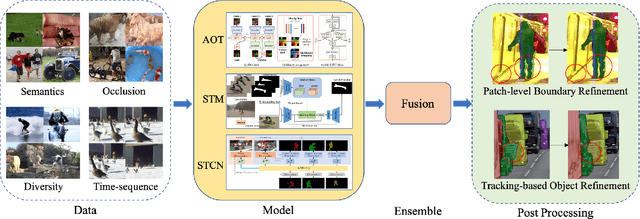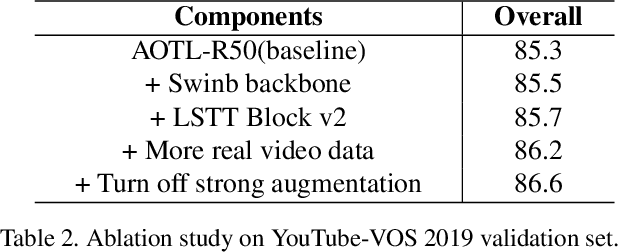Wangwang Yang
3rd Place Solution for PVUW Challenge 2023: Video Panoptic Segmentation
Jun 11, 2023Abstract:In order to deal with the task of video panoptic segmentation in the wild, we propose a robust integrated video panoptic segmentation solution. In our solution, we regard the video panoptic segmentation task as a segmentation target querying task, represent both semantic and instance targets as a set of queries, and then combine these queries with video features extracted by neural networks to predict segmentation masks. In order to improve the learning accuracy and convergence speed of the solution, we add additional tasks of video semantic segmentation and video instance segmentation for joint training. In addition, we also add an additional image semantic segmentation model to further improve the performance of semantic classes. In addition, we also add some additional operations to improve the robustness of the model. Extensive experiments on the VIPSeg dataset show that the proposed solution achieves state-of-the-art performance with 50.04\% VPQ on the VIPSeg test set, which is 3rd place on the video panoptic segmentation track of the PVUW Challenge 2023.
5th Place Solution for YouTube-VOS Challenge 2022: Video Object Segmentation
Jun 20, 2022



Abstract:Video object segmentation (VOS) has made significant progress with the rise of deep learning. However, there still exist some thorny problems, for example, similar objects are easily confused and tiny objects are difficult to be found. To solve these problems and further improve the performance of VOS, we propose a simple yet effective solution for this task. In the solution, we first analyze the distribution of the Youtube-VOS dataset and supplement the dataset by introducing public static and video segmentation datasets. Then, we improve three network architectures with different characteristics and train several networks to learn the different characteristics of objects in videos. After that, we use a simple way to integrate all results to ensure that different models complement each other. Finally, subtle post-processing is carried out to ensure accurate video object segmentation with precise boundaries. Extensive experiments on Youtube-VOS dataset show that the proposed solution achieves the state-of-the-art performance with an 86.1% overall score on the YouTube-VOS 2022 test set, which is 5th place on the video object segmentation track of the Youtube-VOS Challenge 2022.
 Add to Chrome
Add to Chrome Add to Firefox
Add to Firefox Add to Edge
Add to Edge